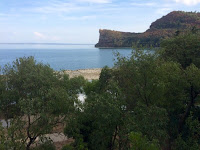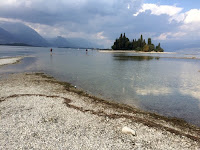 After returning to Lake Como turned out to be rather a wash (more on this later), H and I decamped to the shores of Lake Garda (Gardasee, Lago di Garda and known in antiquity as Benaco where Roman forces defeated the Alamanni confederation—whose name is lent to the French and Spanish exonyms for Germany although Deutschland is Germania in Italian).
After returning to Lake Como turned out to be rather a wash (more on this later), H and I decamped to the shores of Lake Garda (Gardasee, Lago di Garda and known in antiquity as Benaco where Roman forces defeated the Alamanni confederation—whose name is lent to the French and Spanish exonyms for Germany although Deutschland is Germania in Italian).
 We chose a nice site on a south-western peninsula of the lake called Manerba del Garda—pleasantly peopled but not over-crowded since high-season was over but yet not too cold for a dip in the water. This region in general has been a sheltered one—eons before the tourist crunch, due to its climate and is the most northerly clime for citrus orchards, particularly lemon trees but not neglecting wine and olives, and the fact that many structures have foundations that reach into pre-history and neolithic times is probably a reliable indicator of the weather. The silhouette of La Rocca greeted us every morning, framed dramatically by welling clouds and though perhaps not the highest cliff on the lake, it was certainly the closest.
We chose a nice site on a south-western peninsula of the lake called Manerba del Garda—pleasantly peopled but not over-crowded since high-season was over but yet not too cold for a dip in the water. This region in general has been a sheltered one—eons before the tourist crunch, due to its climate and is the most northerly clime for citrus orchards, particularly lemon trees but not neglecting wine and olives, and the fact that many structures have foundations that reach into pre-history and neolithic times is probably a reliable indicator of the weather. The silhouette of La Rocca greeted us every morning, framed dramatically by welling clouds and though perhaps not the highest cliff on the lake, it was certainly the closest.
 The old town centre rising up on a hill more inland was something to behold as well, but what we found to be the most delightful accent to the peninsula demarcating just one protected cove was the Isola San Biagio.
The old town centre rising up on a hill more inland was something to behold as well, but what we found to be the most delightful accent to the peninsula demarcating just one protected cove was the Isola San Biagio.
 Separated from the main beach by barely a shin’s depth of water, one could walk to the little island along a path of pebbles to discover (though privately-owned, entrance just seemed to be not brining in outside beverages or dogs and maybe a visit to the snack-bar) free range bunnies (conigli). They were everywhere—tame and underfoot like the growing flock of ducks that visited every morning just in time for breakfast.
Separated from the main beach by barely a shin’s depth of water, one could walk to the little island along a path of pebbles to discover (though privately-owned, entrance just seemed to be not brining in outside beverages or dogs and maybe a visit to the snack-bar) free range bunnies (conigli). They were everywhere—tame and underfoot like the growing flock of ducks that visited every morning just in time for breakfast.
The rabbits appeared among the tents later on as well. Perhaps this reserve had origins as stock for a private hunt—which happily does not seem to be customary any longer, but makes me think rather on the origins of Manerba, which is believed to have been founded round a grove sacred to the goddess Minerva—the patroness of the hunt and harvest and other virtues besides. This Etruscan avatar of Athena overlaps what is properly the bailiwick of Artemis but there was a lot of cross-over for champions and I wonder if the keeping of bunnies did not reach back that far and into mythology as well.
Sunday 20 September 2015
lake garda or watership down
catagories: 🇮🇹, 🏕️, 🦆, myth and monsters, travel
Saturday 12 September 2015
Friday 11 September 2015
hiatus or ciao bella
We at PfRC have only had the chance to take one grand vacation this year—which we’re forever grateful for knowing that most do with a lot less and thankful too that this is an anomaly and not a worrisome trend, but happily we will have the chance to return to the Italian Lake District in a few days and returned from further adventures we will be refreshed and ready for more. In the meantime, you can visit our friends over at the Smörgåsblog or consult our extensive archives. Arrivederci!
Thursday 10 September 2015
5x5
you know that’s Cyndi Lauper singing: a look into the making of the opening of Pee-Wee’s Playhouse
your hit parade: Kottke looks at the reemergence of the cover song and the throwback economy of imitation
bus stop sally: wonderfully bizarre public transport shelters of the USSR
tipple: specially designed snifter for enjoying a fine beverage in a micro-gravity environment
Wednesday 9 September 2015
hermes trismegistos or copernican revolution
I was familiar enough, I thought, with legendary the Prague (Praha) of the late Renaissance and dormitories and laboratories constructed on the castle grounds for research into alchemy and the esoteric arts, but failed to appreciate that this commission and many of the scattered artefacts, both tangible and in the realm of ideas that challenge received knowledge, have a singular provenance thanks to the curiosity of one practitioner and patron, Hapsburg Emperor Rudolf II.
Not only did the discipline of chemistry develop out of the magicians’ trial and error—the aim was not to transmute base metal into gold but because gold did not rust, it was considered incorruptible and thus immortal—but also many mystic writings, including the undeciphered oddity known as the Voynich manuscript, were gathered together, studied in view of endless galleries of curio-cabinets.
These Wunderkammern were of course a treat to show-off to visiting dignitaries and an unparallelled collection of liminal objects which blurred the divide between Nature and artifice that also made a statement of the might of the Emperor—especially during a time of messy war with the Turks and the Finns—but primarily, there in the study-hall, were catchments of the art of memory and imagination. Polymath Pierre Hérgony himself was also a compatriot. University education or the time involved little research or experimentation and certainly did not invite unorthodox thought. There is quite a bit to unpack here and sadly the catalogue was broken up, lost, destroyed or hidden away—the perpetual motion machines, grimoires, unicorn horns and other unverified relics, so it is hard to declare Rudolf’s greatest legacy, but among the top contenders would certainly be the Emperor’s engagement with astronomers Tycho Brahe and Nicholas Copernicus, who during their tenure at court moved the centre of the Universe from Earth to the Sun and finally to a point in the void, a focus, around which the worlds revolved.















